Carburetion and TBI run at a much lower fuel pressures than MPI systems. BBD carburetors require only 4-5 PSI fuel pump pressure! The 2.5L TBI normally runs 14-15 PSI. 1991-95 MPI systems operate at 31-39 PSI. Normal pressure for a TJ system is from 49.2 +/- 5 PSI, depending upon the model.
If you install a 4.0L engine in any 1987-90 YJ chassis, be certain to upgrade all fuel hoses to high pressure EFI hose and clamps. Pressure can run higher from the fuel pickup point at the tank through the entire MPI system.
Note—1987-90 YJ Wrangler 2.5L fours came with TBI and an electric fuel pump in the tank. If you plan to install a Jeep 4.0L inline six in place of an early YJ Wrangler or XJ Cherokee’s 2.5L TBI four, you can take advantage of the similarities between the 1987-95 YJ Wrangler fuel tanks. On a 4.0L swap into a 1987 YJ Wrangler, I installed a Mopar Reman ’91-’95 YJ in-tank electric fuel pump/gauge sender module to deliver fuel. (See this section’s article on fuel tanks and in-tank pump replacement.)
The 4.0L and 2.5L Jeep MPI engines have two types of fuel delivery systems. Some models use a two-line (supply and return lines) method with a pressure regulator at the fuel rail. Second generation fuel systems use a single supply line with a fuel tank mounted filter/regulator assembly to maintain the fuel pressure. A single rail system eliminates the need for a second fuel pipe between the engine and fuel tank.
Note—You can quickly distinguish a Jeep 4.0L or 2.5L engine by the number of fuel lines at the fuel rail. A single rail system has no pressure regulator at the rail. What looks like the earlier pressure regulator is actually a pressure damper.
1997-2002 four-cylinder 2.5L MPI engines use a device similar to the pressure regulator. This is a damper, however, and not the fuel pressure regulator. These models use a filter/regulator at the fuel tank like the 4.0L chassis. The damper is strictly to offset electric fuel pump pulsing and smooth out pressure at the fuel supply rail.
Some 2.5L MPI dampers use a vent line to the manifold that looks much like the 1991-95 pressure regulator system. This, again, is strictly a fuel rail damper system. Later Jeep models incorporate a damper into the rail system as well. The 4.0L damper is at the middle of the rail. The 2003-up 2.4L DOHC four also uses a fuel rail damper on its MPI system.
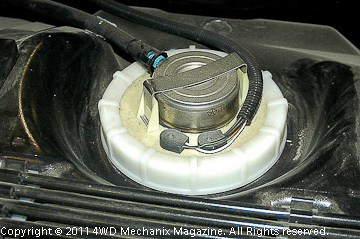
This is a TJ Wrangler tank-mounted fuel pressure filter/regulator unit. The TJ filter/regulator returns excess fuel directly into the fuel tank. This eliminates the need for a fuel return line from the engine fuel rail. The filter seldom needs attention and does not have a routine service or replacement interval. A sock filter at the base of the fuel pump module prevents most contaminants from reaching the filter/regulator.

This is a single-hose fuel rail typical of TJ era engines. On many TJ engines, what looks like a pressure regulator is actually a fuel damper. TJ 4.0L engines have a streamlined rail like this one. A capped pressure check valve is to the right of the fuel supply inlet. On the final generation TJ fuel systems, 4.0L engines that incorporate a fuel damper at the middle of the fuel rail, normal system pressure is 49.2 PSI plus-or-minus 2 PSI. Always bleed pressure properly before attaching a pressure gauge.
Note—The factory procedure for bleeding these later, 49.2 PSI TJ systems involves disconnecting the fuel pump relay at the Power Distribution Center and removing the fuel tank cap. Run the engine until it stalls, cranking further to lower pressure. Key OFF, an injector lead is disconnected. A lead is attached to one injector terminal and the positive (+) post of the battery. A second lead attached to the other injector terminal is then touched to the battery (-) post away from the engine. Apply current for just a few seconds or the injector will be damaged! This opens the injector and drops pressure further. Now, the pressure valve or quick-connect hose fitting can be opened, using rags to catch any spillage. When done with the pressure check or repair, there will be DTC codes stored due to the removal of the fuel pump relay. Install the relay and clear the DTC codes.
Warning—Do not allow gasoline to reach a hot manifold or engine part! Avoid sparks around raw gasoline. Wear fuel-proof mechanic’s gloves and suitable eye protection when releasing fuel pressure or working around injectors!
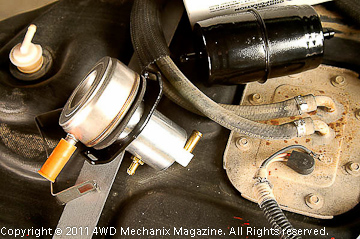
Mopar Performance adapted the TJ fuel-pressure filter/regulator to mount away from the fuel tank. For the updated 4.2L MPI conversion package, the engine fuel rail is a TJ style single hose type. This adapted regulator mounts in-line between the fuel pump and the fuel supply line to the engine fuel rail. The small, third fitting accommodates the return hose to the fuel tank. With this filter-regulator mounted to the vehicle’s frame near the fuel tank, the return hose routes promptly back to the OE fuel return pipe at the tank.
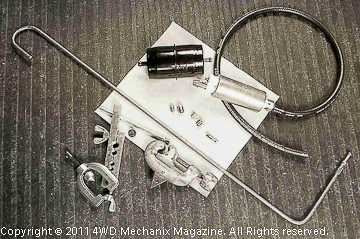
Here is the fuel delivery plumbing for a Mopar EFI conversion. Fuel hose, filter and high-pressure electric fuel pump are part of the Mopar Performance MPI kit. On this installation, I formed and made ends for the steel pipe shown. Wherever possible, I use steel pipe for high pressure fuel delivery. On runs along the frame or across the body, brake/fuel rated steel pipe is more durable, does not oxidize as rapidly as hose and will better resist damage from debris. Even high-pressure hose can swell and will deteriorate over time.
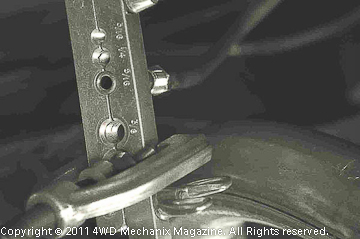
Chassis-to-body or chassis-to-engine points require the flexibility of high-pressure rated EFI hose. On long chassis runs of fuel line, I opt for brake/fuel rated steel lines. For hose attachment points, I cut the steel pipe squarely then create a half or “bubble” flare to secure the hose. The bubble is the first stage of a double flare and can be done with a common flaring tool.
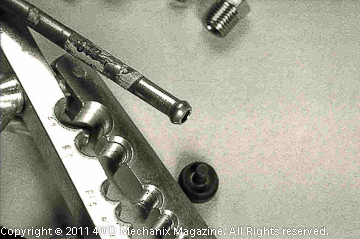
Finished bubble flare looks uniform and capable of keeping a hose from blowing off the tubing. (Straight tubing without a bubble flare is dangerous and should always be avoided on fuel lines.) The hose and clamp will be well past the bubble, and the bubble flare keeps the hose from coming loose under pressure. Always de-burr and air blow tubing to make sure it is clean before operating the system.

Here is one method of mounting the fuel filter supplied in the Mopar EFI kit. EFI/MPI requires exceptionally clean fuel to keep injectors working properly. I always use high-pressure, fuel injection type clamps at the filter and fuel pump hoses. “European” style EFI band clamps with a screw and nut work far better than worm gear clamps. Worm gear clamps have serrations that can cut into the hose. These high-pressure EFI clamps lay flat against the hose, providing a secure, long-lasting connection.
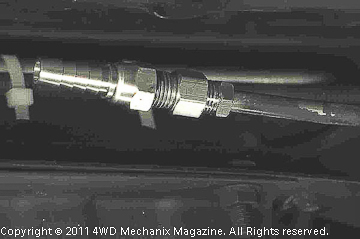
Here, I use double-flare tubing, a flare nut, flare fitting and hose fitting to provide a positive, secure feed to the fuel pump. For this application, the pre-filter and supplied pump each mount inline. From the fuel pump outlet to the filter-regulator (if used in a conversion) and MPI rail at the engine, I will run high-pressure EFI rated hose with EFI clamps and lengths of steel pipe where possible. This fitting and pipe begins the high-pressure frame rail supply line to the engine.
Note— I fit the pre-filter between the tank pickup and the fuel pump. This is not the TJ-style filter-regulator that is also provided in the updated MPI conversion kit. The adapted filter/regulator mounts in-line just after the fuel pump as noted in the kit’s instructions.
Caution—Even with installations that use an in-line fuel pump, I use high-pressure rated EFI hose and steel pipe (if an option) from the tank to the fuel pump. Although the pickup side of the pump is not a high pressure draw, quality EFI rated hose is of benefit and recommended. In-the-tank pumps deliver high pressure from the fuel tank sender and fuel pump module all the way through the system. Keep hoses clear of sharp edges and avoid tight bends that could lead to hose kinks.
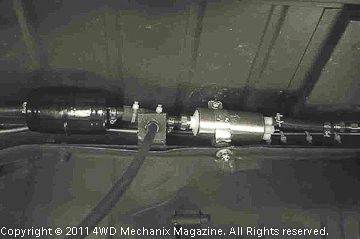
Here, the pump pickup side is at the left, with steel pipe and a connecting hose to the pre-filter. Hose connects the filter to the fuel pump inlet. The pressure side of the pump faces to the right, with a short, high-pressure hose link to steel fittings and double-flare fuel tubing. The tubing at right will go from the crossmember to the left (driver’s side) frame rail. Steel tubing will carry along the frame rail, held in place by OE-type insulated clamps. All hose and hose clamps are high pressure (EFI or better) rated.
Note—An oversized hose is visible between the pre-filter and the pump. This hose wraps around the fuel hose and is held in place with white tie straps. The outer hose protects the fuel hose from debris, damage and oxidation.
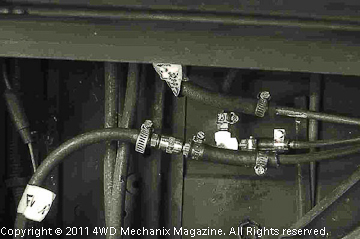
Marking the fuel supply, fuel return and evaporative emission hoses proves smart. This could be confusing during the routing of the evaporative canister hose to the rear of the vehicle. Locating the fuel supply and return lines is crucial. Once the routing is clear, fresh EFI-rated hose and clamps can renew the performance of the vehicle. Fuel leaks are hazardous and must be avoided. If you need to route hoses, keep them flexible and well away from sharp edges.

My hose of choice is a fuel rated, 350 PSI working pressure type. These EFI clamps are also rated for high pressure fuel lines. NAPA offers this special hose. More expensive than common 50 PSI-rated EFI hose, this hose can tolerate the 95 PSI pressure potential of a kinked or clogged MPI system. MPI fuel pump pressures can reach this level when there is a defective pressure regulator or restriction in a fuel return line. With bubble flaring on the tubing, this system will work!
Note—When stiff hose like the 350 PSI type is difficult to slide over a bubble flare, I use spray silicone lubricant to provide the necessary slip. While wet, the silicone lube will allow the hose to move onto the pipe. As the lube dries, the seal is firm.
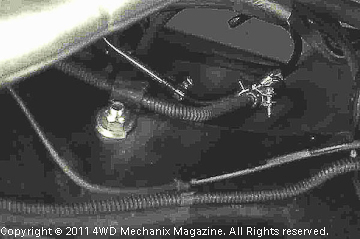
Hose works at chassis-to-body and tank-to-frame points. Attachments to the engine also require flexibility, as the frame, body and engine can move separately from each other. Here, I attach hose to steel pipe at a point where the line must leave the frame. Hose provides a flexible section to link frame rail steel pipes to the steel pipes of the EFI/MPI system at the engine. I use insulated clamps to support the length of steel pipe running along the frame rail.
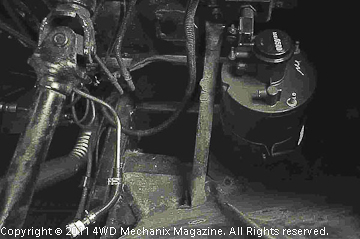
The Mopar MPI kit includes a new evaporative canister. In this chassis, the canister fits best at the driver’s side. On most YJ applications, the OEM location for the canister is beneath the battery at the right side of the chassis. This can work well or often better, leaving the driver’s side more open for mounting the PCM computer. On the 1987-90 YJ chassis, consider the canister’s OE location first.
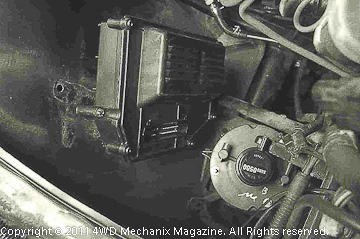
This is the engine powertrain control module (PCM) unit mounted at the fender well. The 60-Way (pin) computer is common to 1991-95 YJ 4.0L engines. Durable and reliable, this unit comes with the Mopar Performance MPI package. TJs with OBD-II use either three 32-Way or three 35-Way connectors at the PCM. The Mopar MPI conversion emulates the YJ system, including high quality, pre-wired harnesses with OE style connectors.
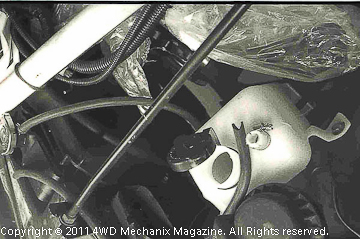
A new coolant recovery tank is included in the MPI conversion package. Note that I cut a forked “V” in the coolant pickup hose. This will help prevent the hose suction from attaching to the bottom of the tank in service. Mopar Performance considered the important accessories that this retrofit will require.
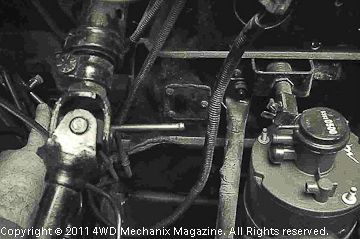
On this application, the new evaporative canister and bracket are at the left side of the frame. The evaporative frame line to the back of the vehicle runs down the right side of the frame. Rather than use hose over the firewall and a hot engine, I formed a section of steel tubing with bubble flares at each end. Here, one of the firewall clamps is attached. The tube, supported by insulated clamps, runs over the transmission tunnel at the firewall. Hoses attach to the evaporative canister and right side frame pipe.
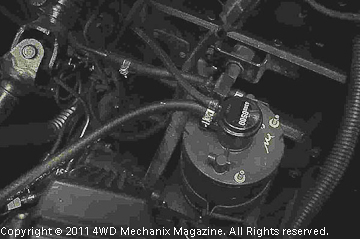
Here you can see the evaporative canister hoses. Note their routing and the caliber of fuel-grade hoses and clamps. The evaporative system is not only a legal necessity, the entire MPI system and powertrain management rely upon correct evaporative canister functions. A sealed and properly pressurized fuel tank and evaporative system assure control of harmful fumes and a breathing engine crankcase. Kinks or crossed hoses can prevent the system from working properly.
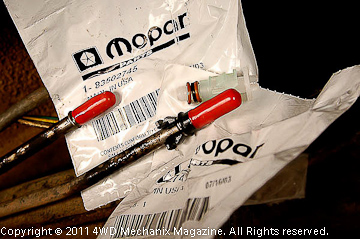
In the conversion to a 4.0L six and MPI, I use the factory fuel pipes wherever practical. The factory hose connections on this 2.5L TBI chassis require special tools and care to uncouple. If a coupler becomes damaged, Mopar makes the repair kit shown here. I will use high-pressure EFI hose and clamps to link these pipes to the Mopar MPI steel pipes. Keep fittings clean of debris, and strive for safe and lasting results.
Note—The OE fuel filter on the frame rail will be replaced by the filter/regulator provided with the Mopar MPI Conversion Kit. A “pre-filter” (similar to the OE frame-mounted filter) mounts between the tank hose and the remote fuel pump supplied with the MPI kit. The filter/regulator mounts after the remote fuel pump outlet, on the supply line to the engine.
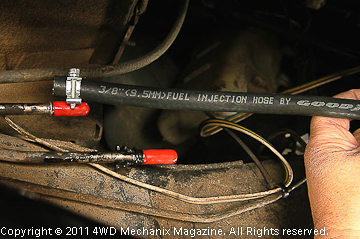
Here I will join the MPI kit’s supplied EFI hose to the OE fuel supply pipe on this 1987 2.5L TBI chassis. The TBI fuel pipe has a shoulder for the hose coupler’s spring clips. I will push the hose past this shoulder. The shoulder will serve much like a bubble flare. The high grade EFI clamp will attach past the shoulder. Once secured past the shoulder, the clamp will keep the hose from blowing off the pipe under pressure.
Note—There is the single supply line, the short return line from the kit’s adapted filter/regulator and an evaporative canister-to-tank line. I will mount the new evaporative canister in the stock location below the battery box to create a “factory” installation. I illustrate two Mopar MPI Conversion installations in these articles. The one using the remote (supplied) fuel pump is the typical 1987-90 4.2L chassis application targeted by the Mopar Performance 4.2L MPI Conversion package. I note the differences between the 2.5L TBI and 4.2L YJ chassis to benefit those owners who intend to swap a 4.2L (MPI converted) or ’91-up YJ/TJ 4.0L MPI six into a 1987-90 YJ Wrangler 2.5L TBI chassis.
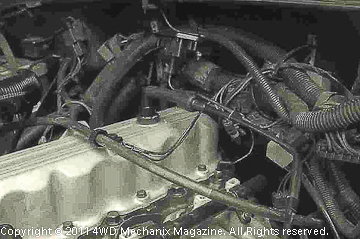
The PCV system is a mainstay device on emissions systems. Closed crankcase devices have existed since the WWII MB Jeep was equipped for fording water in the Pacific Islands and facing the dust hazards of the North African desert. Mopar includes the PCV system as part of the MPI conversion. Note the quality ground wiring provided with the system as well. Proper grounds are critical to system performance.
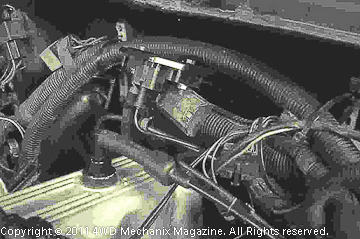
The manifold absolute pressure (MAP) sensor is the key to atmosphere and altitude adjustments. Drawing a signal from the intake manifold, the MAP sensor, mounted at the firewall above the valve cover, provides the PCM with ongoing information. The closed crankcase PVC helps maintain a clean crankcase and controls pressure within the engine. MAP is an important signal in closed loop fuel-and-spark management systems. Mopar provides a new MAP sensor with the conversion kit.
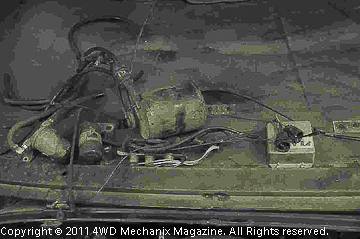
These parts are no longer needed on an MPI converted CJ or YJ chassis. The Mopar MPI conversion provides a new evaporative canister and the hoses and clamps for routing the emissions and evaporative systems. Here, the distributor ignition module is eliminated and replaced by the MPI system’s PCM and ignition coil. The conversion still uses a distributor to deliver PCM-timed spark to each cylinder.
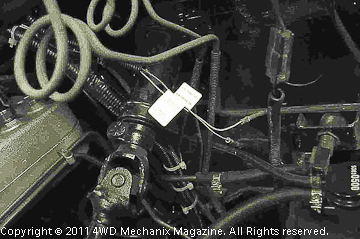
The tachometer and engine check light leads are furnished. Tachometer pulse requires an aftermarket tachometer and will not work with the OEM 1981-90 tachometers. Installing a simple LED light at the dash would enable use of the engine check lead. If the light comes on, you know that a DTC (diagnostic trouble code) has been stored in the computer.
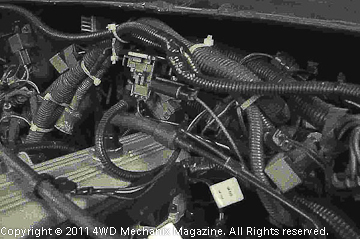
An overview of the PCV, MAP, wire looms and grounds reveals the quality of the Mopar conversion pieces. This looks “factory” and similar to the 1991-up MPI systems found on YJ and TJ Wrangler models. Harnesses provide quality grounds. Always run battery cable sized ground (-) leads from the battery to the engine block and body. The valve cover, in this case, is a quality ground (-) source for the MPI harness ground wires.
Caution—Ground points must not create resistance or a voltage drop, or the PCM signals will be inaccurate. The body and engine must be grounded properly to provide the correct voltage signals to the ECU/PCM computer. Too much resistance will create false voltage readings.
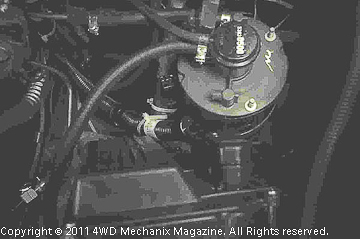
This is the plug at the “60-Way” connection of the PCM. The computer connector is a critical part of the MPI system. Although waterproof, the PCM will not operate when submerged—like in a stream! The connector and computer should be installed at a location that will protect and shield the assembly from water and debris. Mopar kit uses a factory type plug and wiring bundle to provide the best connection possible. I have installed the computer on the backside of the inner fender well.

The injector wiring is marked. Injectors open sequentially—just like the spark plug firing order. On 4.2L and 4.0L sixes, the order is 1-5-3-6-2-4, common for inline sixes. For the 2.5L and 2.4L fours, the firing order is 1-3-4-2, also common. Inline six-cylinder engines number 1-2-3-4-5-6, with #1 at the front. Fours number 1-2-3-4, front to rear. Injector plugs connect in the sequence noted on the tags.
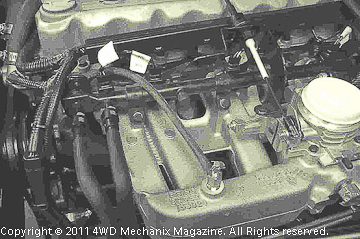
This system is like the OE 1991-95 MPI. Two hoses attach to the fuel rail, one returning excess fuel to the fuel tank. The pressure regulator receives a vacuum signal from the intake manifold and holds a constant pressure at an idle around 31 PSI once the engine is warmed up. At cranking, pressure is around 39 PSI on this two-hose system. On 1997-up TJ applications, there is only a supply hose to the fuel rail. The pressure regulator is at the fuel tank and holds pressure at 49.2 PSI plus-or-minus 5 PSI.
Note—Later fuel rails incorporate a fuel damper as well. When testing fuel pressure, note the specifications for the engine year and model application. Follow test tool instructions, including the first step of safely bleeding pressure from the system.
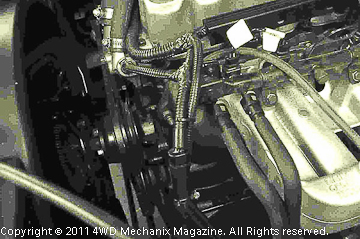
Here, the two-hose (YJ-style) MPI system is clear. The pressure regulator is at the end of the fuel rail. Right side hose is the fuel supply from the fuel tank. The left hose is the fuel return. The regulator maintains pressure and returns excess volume to the fuel tank. This system is constantly under pressure and must be bled safely. The capped pressure check valve sets to the right of the hoses on the fuel rail.
Warning—Disconnect the battery negative (-) cable before bleeding the fuel rail. Never allow gasoline to spray uncontrolled from the check valve! Protect your eyes and eliminate all fire and heat risks when working with gasoline. When bleeding pressure, use a bleeder hose, valve and container placed away from the engine heat and sparks.
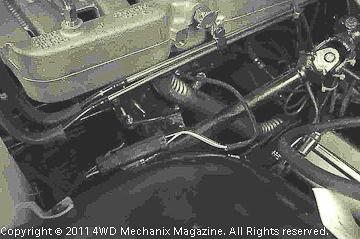
The oxygen sensor plays a key role in fuel-and-spark management. Reading the oxygen content of the burned fuel in the exhaust stream, the O2 sensor provides air/fuel ratio data. In just milliseconds, the PCM adjusts injector fuel flow (pulse widths) and other functions to maintain optimal fuel burn and combustion. 14.7:1 air/fuel is optimal burn or “stoichiometric” for gasoline. While accelerating, when under heavier loads and during cold-start warm-up, the engine requires richer air/fuel ratios. The Mopar MPI conversion kit includes an OE type oxygen sensor and wiring.
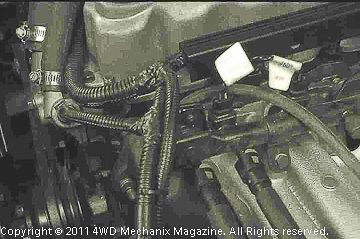
At the thermostat housing provided in the kit, there is a coolant temperature sensor (CTS) to provide the engine temperature signal. This is common to TBI and MPI engines. Mopar also provides a wiring harness that is factory caliber and uses OE connectors for secure and accurate signals. The integrity of wires is apparent, providing the kind of service expected of factory engineering.
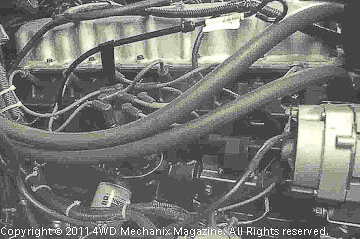
The right side of the 4.2L engine looks much like a 4.0L found in 1991-99 YJ/TJ models. A distributor and spark leads provide spark to the plugs with the ignition coil mounted just forward of the distributor. On 4.2L engines, the coil mount doubles as the former fuel pump’s block-off plate. (4.0L engines do not have the mechanical fuel pump provision.) 1999-2006 TJs and 2000-2001 XJ Cherokees have no distributor. Distributorless ignition (coil pack) places coil gangs at the spark plugs.

The Mopar MPI conversion includes all wiring harnesses routed in OE type convolution tubing. A lead goes to the battery and ignition/primary wiring sources. I route this sleeved bundle across the firewall and secure the other harnesses in convolution tubing. When using plastic ties, be sure that wires are protected within the sleeves. Ties tightened directly against wires can wear into the wire insulation over time.
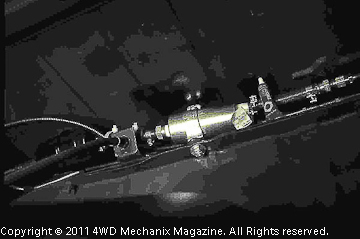
I use Loctite Threadlocker 242 on the nuts that hold connectors to the in-line fuel pump. You want the fuel pump to deliver reliable performance under the worst of driving conditions. My connectors are solder type (Solid Seal or equivalent) rather than simple crimp. (Warning—Do not use heat tools or an open flame anywhere near gasoline or a gasoline fume source!) The fuel pump must operate with a fused relay circuit triggered by the PCM. The Mopar wiring harnesses assure these functions.
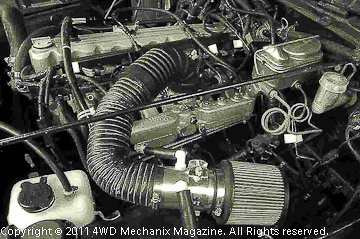
Mopar Performance provides a performance induction system with the MPI conversion. This system uses an open face air cleaner for maximum flow and no restrictions. I mount open-faced filters in a place where they will not get exposure to water or debris. A large dose of water hitting this filter—like plunging a running Jeep into deep water—could rush through the intake system and hydro-lock the engine. Severe engine damage would result.
Warning—Always shield or protect an open faced air cleaner. Debris or, worse yet, a strong dose of water could impact this kind of filter and cause severe engine damage.

This is the complete installation of the Mopar MPI package. 1981-90 CJ and YJ models can have all the advantages of MPI plus 50-State legal status. (The package will also fit most AMC/Jeep 258 engines back to 1976.) This system has tested and earned California C.A.R.B. emissions exemption status under Executive Order D-265-14. A cleaner than original tailpipe and significant performance improvements have made this a popular and valued upgrade.
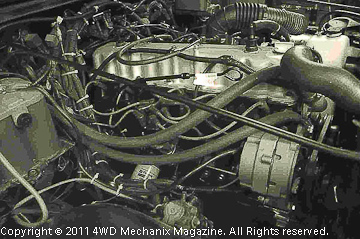
Servicing the MPI converted engine is much like working on 1991-up YJ and TJ models. Spark plugs, the oil filter, the distributor, coil and alternator are each accessible. The starter motor remains easy to reach. In effect, the engine looks cleaner and more streamlined, with the original gangs of vacuum and electrical solenoids no longer a part of the emissions package! Owners planning to keep their 4.2L CJ Jeep or YJ Wrangler should consider this option.
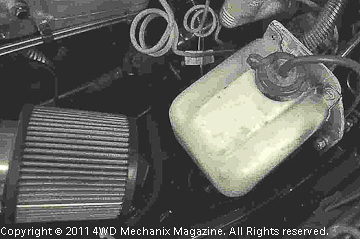
Small loose end details accompany most MPI conversions. Here, I have relocated the windshield washer bottle, making a bracket mount. Mopar instructions suggest the use of Mopar washer bottle P/N 55154744 and bracket P/N 55026288 as retrofit pieces. There are other useful details that Mopar addresses in the instructions provided with the Mopar MPI Conversion for 4.2L/258 cubic inch engines.
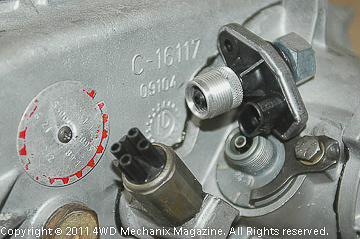
Mopar Performance includes a vehicle speed sensor (VSS) for the cable-type speedometer in 1981-90 Jeep CJ and YJ vehicles. This adapted piece fits neatly at the OE speedometer output of the transfer case and provides the PCM with vital vehicle speed information. With the introduction of the TJ models, the speed sensor is a fully electronic device, and the speedometer no longer requires a cable.
Note—TJ NV231 transfer cases still use a speedometer drive and driven gear set with the VSS. The gear drives a hall-effect mechanism to generate a signal for the PCM and electronic speedometer. NV241 (Rubicon) transfer cases use a speedometer sensor “tone wheel” on the output shaft. There is no longer a need for the speedometer drive adapter or a gear set.
The Mopar Performance EFI/MPI Conversion updates the early YJ engine and chassis to mid-1990s performance standards. This package contains all of the emissions and evaporative control devices required of 1994-95 YJ MPI 4.0L models. Many of these features carry forward to the TJ Wrangler era. Older devices, like the EGR valve found on 1987-90 YJ engines, are no longer required. The pulse-air system and air injection into the catalytic converter has also been eliminated.
Minor exhaust system modifications include closing and sealing the air inlet tube at the OE catalytic converter. None of the 1991-up YJ or TJ Wranglers use air injection or a “three-way” catalytic converter system. If the OE catalytic converter and muffler have very high mileage, a new performance catalytic converter and muffler would be advisable. This will enable the MPI 4.2L or 4.0L engine to perform at peak, 50-State legal efficiency.
